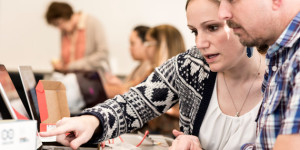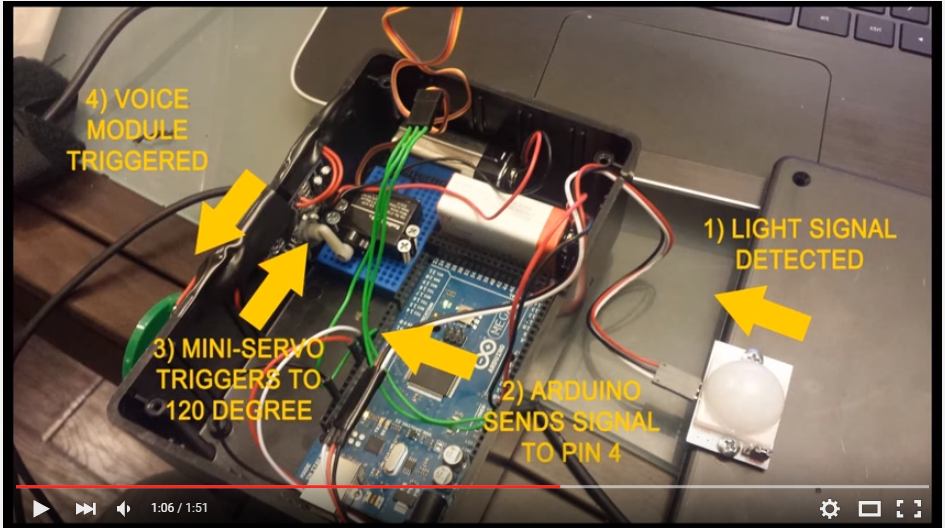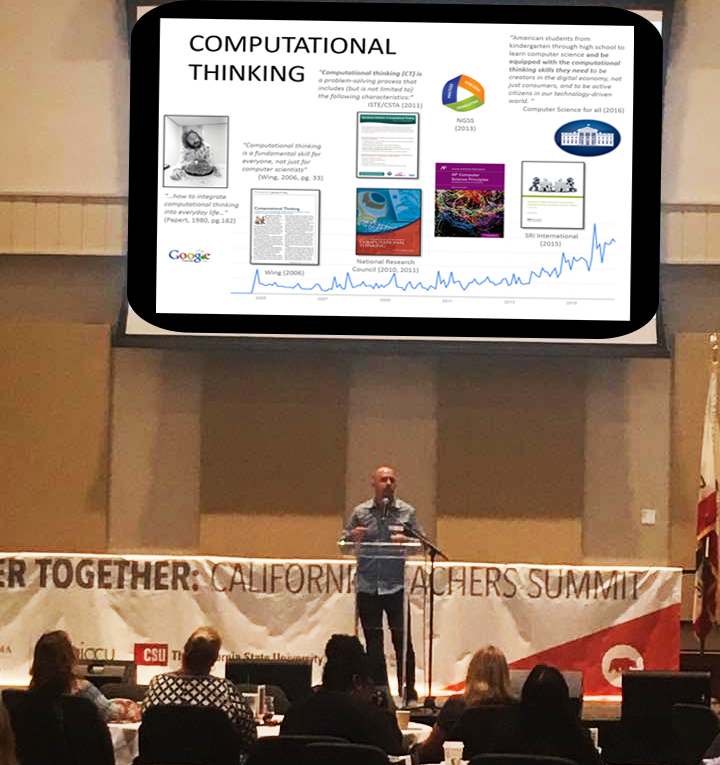Maker and DIY
 A quick web search will turn up millions of results for the words Maker, and DIY, but so far these movements have involved only a relatively small, but growing number of people. The Maker and DIY movements have given birth to a variety of groups and activities. Maker Faires, Maker and Hacker spaces, online Maker and DIY communities, and more, promote the sharing of ideas, domain expertise, tools, community and the creative process. This is accomplished through the creation of artifacts ranging in nature and complexity from simple handmade items to 3D printed creations and everything in between.
A quick web search will turn up millions of results for the words Maker, and DIY, but so far these movements have involved only a relatively small, but growing number of people. The Maker and DIY movements have given birth to a variety of groups and activities. Maker Faires, Maker and Hacker spaces, online Maker and DIY communities, and more, promote the sharing of ideas, domain expertise, tools, community and the creative process. This is accomplished through the creation of artifacts ranging in nature and complexity from simple handmade items to 3D printed creations and everything in between.
Culturally, the Maker and DIY movements have begun to reawaken the idea that ordinary people can and should make things. Particularly in the western world, the consumption of goods and resources that are reliant upon supply chains and mass production, have lulled many people into a rut of creative and productive passivity. The Maker/DIY movements are sometimes seen as more than playful exploration, rather as a rejection of consumerism which has dominated our culture since the industrial revolution. Whether it is backyard craft brewers, community gardeners, Pinterest-inspired crafters or any other number of Maker/DIY activities, people experience learning in powerful ways not often associated with the traditional discussions of learning theory and pedagogy.
The DIY and Maker movements fit comfortably under the umbrella of the theory of Constructivism and the pedagogical practice of Constructionism. Jean Piaget described the internalization process in terms of building schema, or mental constructs of understanding that are continually reconstructed through the processes of assimilation and accommodation. Using Piaget’s cognitive view of knowledge construction, many others have built theories and practice into the sociocultural world. One such example comes from Seymour Papert and his work with the LOGO programming language, which helped introduce educators to practical exercises in constructionism, through interactions with computers and self-directed object programming. Though Papert’s major contribution to Constructionism in formal learning settings was delivered primarily through LOGO and Turtle, Constructionism is certainly mediated in a variety of different ways, but always based on the Constructivist foundation of active knowledge building in a “context where the learner is consciously engaged in constructing a public entity” (Papert and Harel, 1991, pg. 12)
Making and inventing are fun and enjoyable for most people, providing a refreshing aspect of intrinsic motivation in its participants, allowing for organization of activities and environments that are far less reliant upon controlling students through extrinsic motivators to encourage behaviors, and punishments to decrease unwanted behaviors as occurs in many traditional learning environments. Dale Dougherty, founder of both the Maker Faire and Make magazine attributes the origins of the Maker Movement to “experimental play.” He describes Makers as “enthusiasts who played with technology to learn about it.” (Dougherty, pg.1)
The connection between play and learning has been explored in the fields of education and developmental psychology over the better part of the last century. Significant contributions to this discussion are founded on seminal work of Lev Vygotsky. Vygotsky spent time meticulously and thoughtfully observing and writing about how he understood learning to occur naturally through children. Vygotsky discussed the conditions of play allowed for learners to explore new meaning and even new identities, through interactions with culturally mediating objects and with the assistance of more knowledgeable others. (Vygotsky, 1970)
Unfortunately for students of all types, the reality of modern school is that it does not foster play as a form of learning, outside of the first few primary grades. In the world of most learners in formal settings, there are two competing experiences of learning, one intentionally designed and largely contained in a classroom environment, and another as playful beings in the situated world they live in. In class, students learn about subjects not explicitly connected to their lives and in ways that are contrary to what we now know about the learning sciences. Though children and students of all ages maybe engaged in school and subject to interaction with the designed curriculum, arguably the learning that is most impactful occurs when engaged in exploration and play, whether it be inside or outside of the classroom.
Contemporary Learning in the Workplace:
Though not the primary function of most workplaces, training and development of employees is widely recognized as an important element of healthy organizations. Whether it be ultimate goals are to advance the interests of the organization in general through efficiency and effectiveness, communicate and enculturate policy and procedures, or to ensure compliance with legal regulations, employers have a significant interest in the training and development of employees.
Because many organizations contend with the similar issues of needing to train for compliance (e.g. sexual harassment, time card tracking, booking travel, etc.), training often looks very much the same from organization to organization. According to the 2013 Industry survey conducted by Training Magazine, the most common training modalities include: Instructor Lead Trainings (ILTs), followed by Blended Learning, online Modules, and lastly Social Learning. (Training Magazine, 2014)
Looking specifically at the tools and modalities employed by corporate training departments, three quarters of companies use an LMS, virtual classroom or webcasting/video platform to deliver content and instruction. Almost half are using rapid eLearning tools to deliver content and provide some level of interactivity, and roughly 40% reported using application simulation tools. The most frequently reported modalities, especially considering how they are used, illustrate that it is reasonable to conclude that the primary emphasis is on cognitive theories of learning, applied in a largely instructivist methodology, assessed through a positivist epistemology. Generally speaking, learners are viewed as vessels to be filled with the knowledge and wisdom, and to that end that the company dutifully expends its available resources. Because the model largely reflects what employees experienced in school, this seems natural and is culturally accepted as a reasonable approach at managing employees.
Attempts to improve the results and effectiveness of corporate training have led to some expanded offerings, these have improved on both delivery and assessment, by utilizing scenario-based modules and simulations that help tap into a more situated cognition. This serves to reduce the abstractness and disconnectedness of the content into a more relevant and application focused experience. Along with attempts to better situate the cognition of the learner, some organizations have begun to leverage gamification to enhance the experiences of learners. From simple games, to organizational competitions supported by badging and recognition systems are being developed and implemented to increase help engagement and retention of information. Thought they take on different forms, fundamentally all rely on largely extrinsic motivation through rewards.
One trend that seems to be gaining traction in the last several years is the pursuit of informal and social learning opportunities in the workplace. Acknowledging that the traditional form of training isn’t always as effective as would be desired, some organizations have focused more on the curation and sharing of organizational knowledge in learning spaces, often through social business platforms. These platforms generally afford the same types of opportunities through a similar feature set which includes the ability to post and share resources, start and participate in conversations, facilitate group work, and virtual collaboration.
Bringing Constructionism to the Workplace
To have a constructionist learning experience similar to DIY and Maker practice in a corporate setting, learners must have agency in their learning and in their work. Being empowered to make choices whenever practically possible, learners should have choices involved in creation of an artifact that is of relevance to them. This can be accomplished by establishing measurable competencies for domain or subject, and then allowing the learner freedom to select from a crowd-sourced list of other learners’ ideas, or submit their own additional authentic assessment idea.
Even something simple like a change in process training could take on a new form. Instead of constructing a company-wide job-aid, or presentation module for the learners, and assessing learning through a multiple-choice quiz, learners could be given an opportunity to have say and active participation in learning in a manner that’s meaningful to them, and helps to manage the information in a personalized way. Minimally, all learners would need to submit a concept map or one-paragraph reflection on their learning.
In addition to agency being a required element for Constructivist and Constructionist learning in the workplace, workers must be given the space (virtual and physical) to form and participate in various work-related communities. Maker and DIY communities grow and thrive through the sharing of resources and ideas between members of the groups as an essential element of their existence. Because of cost and space limitations in many work environments, this objective can most practically be accomplished in part through the social learning and social business platforms that have begun to appear throughout organizations.
One example that leverages both of the above elements of agency and interaction through social spaces could be a leadership development program that empowers learners to create their own personal artifact in the form of a leadership guide, statement of philosophy or handbook, depending on what is most relevant to them. Giving the learner the opportunity to take ownership of the learning process and direct their energy and attention on things that are meaningful from the start, provides a foundation on which true transformational growth can occur.
The exploration of leadership principles and ideas could certainly occur in isolation, but should ideally happen in the context of and support from a community of peers. Using social-business and social-learning tools already found in many organizations, or available in cloud hosted versions, companies could easily provide platforms for collaboration and sharing of knowledge and expertise throughout the organization, the benefits of which are just starting to be recognized.
Conclusion
Ultimately, without a better-aligned organizational construct to the fundamental principles of maker communities, organizations will have a difficult time truly implementing Constructivist learning opportunities. Analogous to penetration of the DIY/Maker movements in formal educational settings, one can only expect to see small scale, isolated attempts at learning through building. To truly transform training practices in modern corporate culture, there must be a fundamental shift in perception and organization towards what Brown & Duguid (1991) refer to as a “community-of-communities” that are aligned toward the same goal. If the mission of the organization is the same as the mission of the employees and the mission of the school system, is aligned to the mission of the students, learning can begin to truly depart from its instructivist model of control, to a more natural and effective model of learning through making.
References
2013 Training Industry Report. (2014, January 1). Retrieved October 1, 2014, from http://www.trainingmag.com/sites/default/files//2013_Training_Industry_Report.pdf
Brown, J., & Duguid, P. (1991). Organizational Learning And Communities-of-Practice: Toward A Unified View Of Working, Learning, And Innovation. Organization Science, 2(1), 40-57. Retrieved October 10, 2014, from http://ocw.metu.edu.tr/file.php/118/Week11/brown-_organizational_learning_and_communities_of_practice.pdf
Dougherty, Dale. “The Maker Mindset.” Accessed October 4, 2014. http://llk.media.mit.edu/courses/readings/maker-mindset.pdf.
Papert, S., & Harel, E. (1991). Situating Constructionism. In Constructionism (pp. 1-13). Westport: Ablex Publishing.
Vygotsky, L. S. (1978). Mind in society: The development of higher psychological processes Cambridge, Mass.: Harvard University Press.





